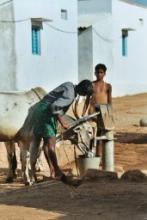India: rural water supply publication
India: rural water supply publication
| Title | India: rural water supply publication |
| Publication Type | Book |
| Year of Publication | Submitted |
| Abstract | A recent book from Unicef reflects upon some of the problems of a narrow focus on drinking water supply. |
| Full Text | A recent book addresses some of the problems caused in rural India by a narrow focus on water for drinking. An extended quote from the book makes interesting reading: “The rationale for Unicef's agreement to support the 'accelerated' rural water supply programme is very significant. The thrust was safe drinking water, to pursue the goal of improved public health particularly of children. In spite of the needs of the Indian farmer for water to irrigate his crops during the dry season, without which his family's food supply would be threatened and children's and women’s' well-being jeopardized from another direction, Unicef's concern was limited to water for drinking and domestic purposes. Indeed, if there had been any mention of agriculture during the debates surrounding the proposal, it would have stopped dead in its tracks. Some advocates of applied nutrition were keen to support domestic water supplies for kitchen gardens as an adjunct of family food supplies, but nutrition programmes were then seen as an adjunct to health in the Unicef perspective. This did not accord with the way community water resources were traditionally viewed, either by villagers or by previous government policy. Given their multiple needs for water, including water to irrigate their crops, villagers in India tend to view the water resources available to them holistically. What they need is water, plain and simple. In many parts of the country little differentiation is made between water for drinking and domestic purposes and water for cultivation. Certain wells and other sources may be favoured for drinking because of their taste or perceived purity, or because they can be more conveniently accessed. Until the advent of the 'problem village' with its exclusive focus on defining water scarcity in terms of water for drinking, government programmes for village water supply had not made this distinction either. But in the late 1960s, influenced on the one hand by the Green Revolution and its emphasis on large-scale irrigated agriculture, and on the other by a new 'water for health' ideology promoted by Unicef and WHO, government policies towards water were for the first time compartmentalized. The long-term implications of this division along sectoral lines were not then perceived but they were to be profound. In fact the idea that they were promoting a departure from the norm did not occur to Unicef, whose new water professionals were schooled in Western public health engineering traditions, where domestic water supplies have no livelihood context and are almost exclusively about washing, cooking and drinking. No one can quarrel with the primacy of water for drinking. Water to drink is indisputably essential for human and livestock survival. But a policy which neglected other basic water needs, and failed to integrate requirements for agriculture and requirements for health has become, in more recent times an albatross of terrifying proportions. Such a crisis has not been anticipated at the time. There was a head of political steam behind village drinking water supplies, and after initial self-doubt, Unicef stood ready to serve.” Read more in Black, M., Talbot, R. 2005. Water a matter of life and health, water supply and sanitation in Village India, Unicef with Oxford University Press, New Delhi. The above quote is from pages 41-43. |

